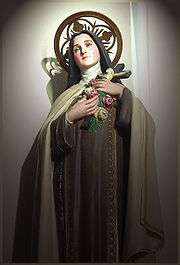The Hidden Face (book)
The Hidden Face is a book on St. Thérèse of Lisieux by the German author Ida Friederike Görres. Originally written in German in 1944 as Das Verborgene Antlitz it is considered the most important work by Görres.
Background
When Gorres first began work on the book at the beginning of the Second World War she wrote that, "not a single encouraging or interested voice was raised among my friends and acquaintances. Really, can't you choose a more important figure, one more significant for our times? Thomas More, John Henry Newman or St Hildegard? Has not all that is necessary, and far more, already been said about this holy little nun?' "
For those around Ida Görres in those years, Thérèse represented the very type of bourgeois Christianity they were resisting. She wrote later that a small, unforgettable incident, shaped her decision to study Thérèse. " During a meeting at Burg Rothenfels, then the centre of the Catholic Youth Movement in Germany (Quickborn - the main Catholic branch of the German Youth Movement) , a student showed me a small picture, like a passport photograph. 'This is the true appearance of Little Thérèse', he said. 'Dom Willibrord Verkade, the monk-painter of Beuron, published it. The Carmel at Lisieux, and a French bishop as well, protested vehemently against its publication.' A small group had gathered round and the picture passed from hand to hand. From that August morning on I was determined to pursue the riddle of her look and her smile - so different from the honeyed insipidity of the usual representations of her. Who was Thérèse of the Child Jesus in reality? "

For the 1959 revised edition of her book, following the 1956 appearance of a four volume critical edition Manuscrits Autobiographiques, Görres was able to consider the effect of the editorial work that Thérèse's sister Pauline had carried out - cuts, stylistic corrections, and most importantly, insertions. " The insertions seem to me the one considerable and questionable element", but she concluded, " The facsimile manuscripts afford no sensational revelations, no fundamental transformations in our picture of the saint." She found that she had not altered her view of the saint.
Chapters:
- II The Nest
- III The Desert
- IV The Way
- V The Breakthrough
- VI Perfection
- VII The Riddle of Glory
Sources
- Ida Friederike Görres, The Hidden Face: A Study of St. Therese of Lisieux Ignatius Press 2003 ISBN 0-89870-927-X